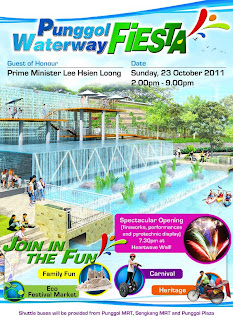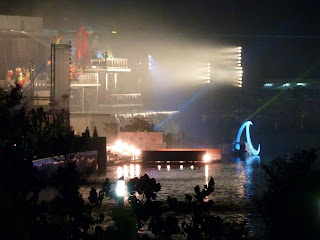 Punggol Promenade is a 5-kilometre long public waterfront promenade serving as a key pedestrian connector for the future Punggol Waterfront Town. Environmental improvement works include an arrival plaza next to the existing beach, a water lily pond park, fishing platforms leaning over the water edge and bridge crossings over canals. Application of sustainable building materials such as GRC simulated concrete, laterite and oxidised steel throughout the promenade makes for an environmentally friendly development.
Punggol Promenade is a 5-kilometre long public waterfront promenade serving as a key pedestrian connector for the future Punggol Waterfront Town. Environmental improvement works include an arrival plaza next to the existing beach, a water lily pond park, fishing platforms leaning over the water edge and bridge crossings over canals. Application of sustainable building materials such as GRC simulated concrete, laterite and oxidised steel throughout the promenade makes for an environmentally friendly development.The newly opened portion of the $16.7-million Punggol Promenade, located along the eastern bank of Serangoon Reservoir is a result of 2 years of construction; the groundbreaking for the riverfront recreational area took place in 2009.
 The estuary of Sungei Serangoon was dammed in 2009 to form the reservoir. The 4.9km promenade has been designated a recreational space for residents in the area. It also links Punggol Point to Punggol East and joins up further south with the park connectors along Serangoon Reservoir and Punggol Reservoir. Only its Riverside Walk portion is accessible currently.Officially opened recently, it is just a short walk from Riviera LRT station. Three food and beverage outlets - a bistro, a seafood restaurant and a fast-food outlet - have also opened in the area. The Riverside Walk features exercise stations, designated cycling and jogging tracks and lookout points that allow visitors to get closer to the water.
The estuary of Sungei Serangoon was dammed in 2009 to form the reservoir. The 4.9km promenade has been designated a recreational space for residents in the area. It also links Punggol Point to Punggol East and joins up further south with the park connectors along Serangoon Reservoir and Punggol Reservoir. Only its Riverside Walk portion is accessible currently.Officially opened recently, it is just a short walk from Riviera LRT station. Three food and beverage outlets - a bistro, a seafood restaurant and a fast-food outlet - have also opened in the area. The Riverside Walk features exercise stations, designated cycling and jogging tracks and lookout points that allow visitors to get closer to the water. The next phase of construction will include a driving range and other facilities. Two other zones, the Nature Walk and Punggol Point Walk, are expected to open later in the year.Nature lovers will also be drawn to the promenade. It is connected by a bridge over Serangoon Reservoir to Lorong Halus Wetland, a biodiversity haven for flora and fauna such as the White-breasted Waterhen and the Striated Heron, also known as the Little Heron. Formerly part of a landfill, it has been converted into an educational site and aims to be a sanctuary for plants, birds and other wildlife.Punggol Promenade Riverside Walk
The next phase of construction will include a driving range and other facilities. Two other zones, the Nature Walk and Punggol Point Walk, are expected to open later in the year.Nature lovers will also be drawn to the promenade. It is connected by a bridge over Serangoon Reservoir to Lorong Halus Wetland, a biodiversity haven for flora and fauna such as the White-breasted Waterhen and the Striated Heron, also known as the Little Heron. Formerly part of a landfill, it has been converted into an educational site and aims to be a sanctuary for plants, birds and other wildlife.Punggol Promenade Riverside Walk


























